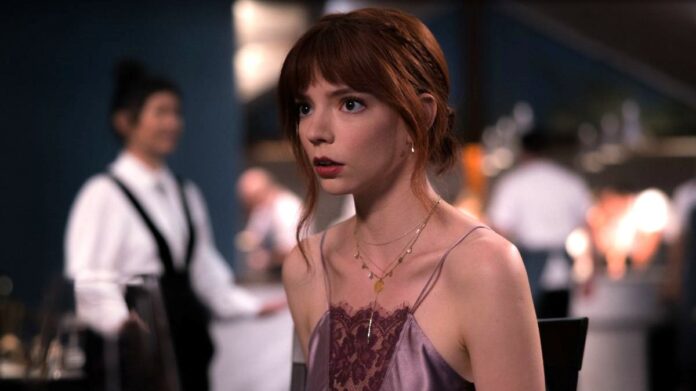“The Menu,” directed by Mark Mylod, spans a single day and follows a young couple as they make their way to an ostentatious restaurant on an isolated island. Margot (Anya Taylor-Joy) is unfamiliar with the shiny, showy world and skeptical, taking her cues from and humoring Tyler (Christopher Holt). One of the first scenes involves them slurping oysters topped with a rare, special type of algae. Margot shrugs and is, to Tyler’s horror, unimpressed. This moment captures the dynamic perfectly. Tyler is infatuated and obsessed with the food of this restaurant and with its chef, while Margot, clearly an outsider to this elite world, couldn’t care less and lets people know. They set foot on the island and then proceed to the restaurant, along with the rest of the limited, exclusive guest list. Margot is confronted twice with the fact that she is a last-minute replacement for Tyler’s intended plus one.
The dinner consists of many courses. Each one is served with dramatic flair by the chef, Julian Slowik (Ralph Fiennes), the star of the evening, who provides context for his dishes in the form of dark anecdotes while his staff works mechanically and meticulously behind him. The guests are presented with bizarre culinary experiments that have less to do with the actual food on the plate (of which there is little) and more to do with its intellectualization of it. Seemingly all at once, the evening unravels: secrets are revealed, and violence ensues, and all through it, the staff assures and reassures the guests that it is all part of the Menu.
Overall, the movie is stylish, theatrical, and visually seductive, with the dialogue shining through with some great comedic moments. The opening sequence and the set-up are playful and exciting, almost following the conventions of a whodunnit. Twelve characters step onto the secluded island, all boisterous and self-involved in markedly different ways, and all—except for Margot—united in their trust in the Menu and the chef. The camera moves rhythmically around the restaurant, providing the audience with snippets of different conversations and dynamics at each table as the first few dishes are served. There is humor and a pulse to the scenes, as writers Seth Reiss and Will Tracy poke fun at the pretentious culture around haute cuisine and the facades of the elitist patrons. It is exaggerated but not unbelievable, and that is where the film shines.
Unfortunately, as the story unfolds, the script loses steam, and the characters that are set up to be insufferable yet compelling end up amounting to nothing interesting, relevant, or even amusing. They do not really engage with each other and lack chemistry when they do.
Each guest at the restaurant is meant to represent a unique social flaw that Slowik takes turns pointing out. But it is precisely this narrative structure that causes the story to lose focus; it becomes loose and unconvincing because the audience has too little to hold on to, feel strongly about, or sympathize with. We do not know the guests well enough to feel for them; what little we do know is superficial and unsympathetically portrayed. We know little of the chef, and when his tragic past or his moral stances are revealed, it is so rushed and insincere that it’s difficult to care or even just keep up. Though an early scene of serving bread with no actual bread (which Slowik says is the food of the common man, which the present company is not) indicates to the audience that the film is going to engage in an analysis of class through the lens of pretentious gourmet culture, the script lacks follow through. Slowik goes on to punish individuals (including himself) for wholly separate issues ranging from the integrity of the artist to sexual harassment and, least convincingly, the disparity between theoretical and practical knowledge of cooking. Each stance the chef takes is weaker than the last, so the violence loses impact, and the climax drags because the stakes are unclear from the beginning.
Anya Taylor-Joy does what little she can with an underwritten protagonist, an edgy yet bland young woman who seems to be the only one to see through the farce from the get-go. A big reveal is that she’s from a working-class background (which in turn sheds light on a couple of gaping plot inconsistencies), and that is meant to be the real reason she doesn’t fit in with the rest of the guestlist and thus throws the chef’s Menu off kilter. Her character is difficult to root for simply because of how much of a “cool girl” she is, without any nuance or subversion offered to the trope.
The film tries to do too much with its messaging, and in doing so, it loses track of what it’s trying to say. But at its core, the film means to champion a dedication to joy rather than perfection and intellectualization, an idea that was elaborated with subtlety and tenderness in the Nicolas Cage-starring 2021 feature “Pig” as well as the 2007 animation success “Ratatouille” before that. That being said, “The Menu” is still an enjoyable cinematic experience, thanks to its well-timed comedic moments and pacy editing that makes it an easy, if not totally coherent, movie-watching experience.

